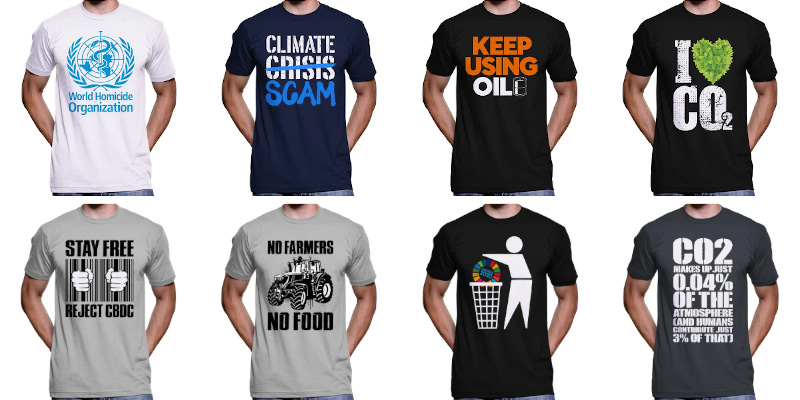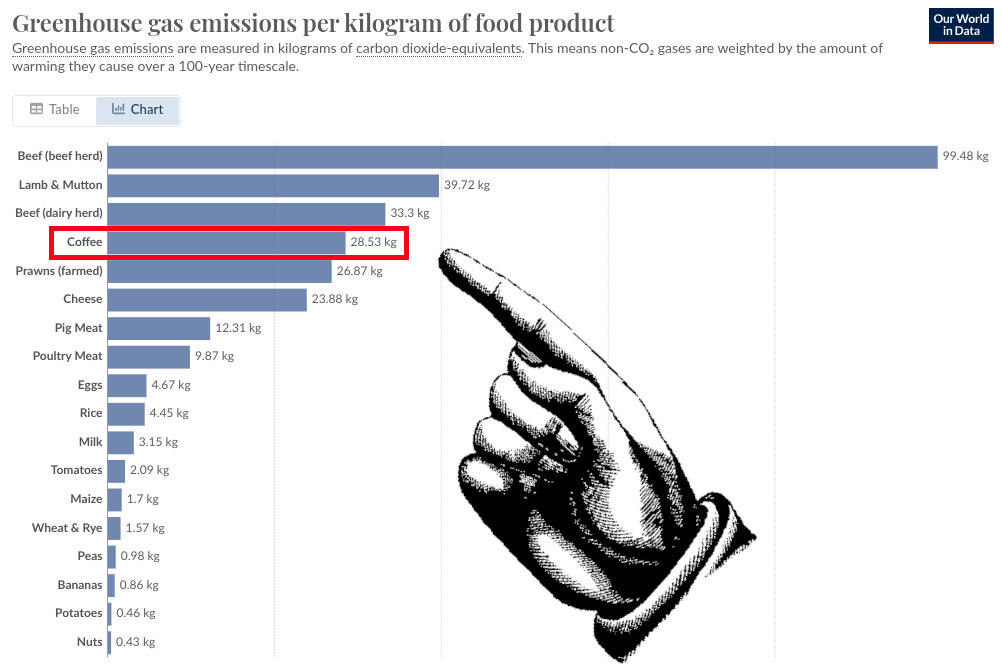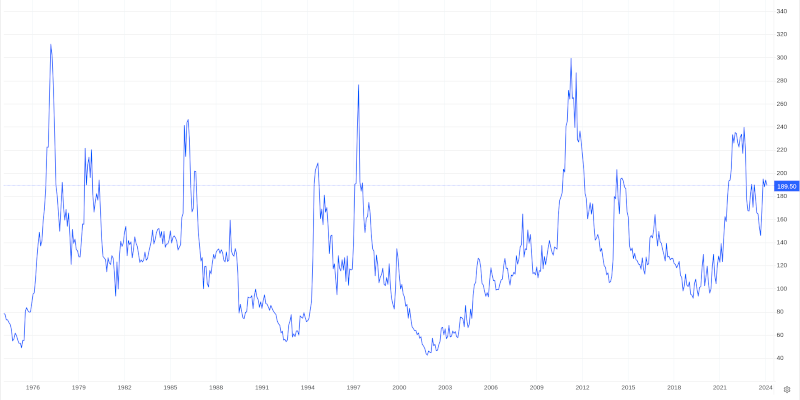
“Basically, the coffee that we all drink, emits between 15 to 20 tons of CO₂ per ton of coffee. So, we should all know that. This is every time we drink coffee we are basically putting CO₂ into the atmosphere.”
That’s Hubert Keller, senior managing partner at the Swiss private bank Lombard Odier, speaking at this year’s World Economic Forum.
Are you turning into WEF-Watch?
No. I’m not a fan of the World Economic Forum though. It’s a meeting for hyper-capitalists, who fly (many in private jets) to the luxury ski resort of Davos in order to give the impression that they want to find solutions for the problems that they created in the first place.
As the economist Michael Roberts points out, they invariably view problems from the point of view of global capital. And their solutions are “driven by the aim to sustain the world capitalist order”.
In 2003, Klaus Schwab introduced the idea of each Davos meeting having a theme. The first theme was “Building Trust”. This year’s theme was “Rebuilding Trust”.
So, why are you writing about a Swiss banker talking about coffee in Davos?
Funnily enough, the WEF’s Global Risks Report 2024 listed misinformation and disinformation as the most severe global risk over the next two years. Here’s how WEF defines misinformation and disinformation:
Persistent false information (deliberate or otherwise) widely spread through media networks, shifting public opinion in a significant way towards distrust in facts and authority. Includes, but is not limited to: false, imposter, manipulated and fabricated content.
There’s plenty of false information flying around this story about a Swiss banker, coffee, and the World Economic Forum.
I’ve been listening to Jon Ronson’s podcast “Things Fall Apart” on Radio 4. Ronson explores various battles in the culture wars. It’s a brilliant series of podcasts, and one of the episodes looks at some of the conspiracies swirling around the World Economic Forum.
At the end of the final episode, Ronson says,
“When untruths spread, the ripples can be devastating. It feels more important than ever to try to hold on to the truth, like driftwood in the ocean. Because if not, we might drown.”
The clip of Hubert Keller talking about coffee and CO₂ went viral on Twitter.1
Keller’s comments about coffee fit neatly into the conspiracy theorists’ and climate deniers’ narrative about the WEF. That narrative goes something like this: The global elites want to take away your free speech, your property, your wood-burning stove, your gas cooker, your privacy, your cash, your light bulbs, and your freedom. They want to stop you driving your car, stop you flying, stop you eating meat, and now, stop you drinking coffee. They want us to live in 15-minute cities, they want a climate lockdown, they want to kill us with vaccines, and they want us to eat insects. All of this will be achieved by the Great Reset.
Naomi Klein describes the Great Reset as,
Less a conspiracy theory than a conspiracy smoothie, the Great Reset has managed to mash up every freakout happening on the internet — left and right, true-ish, and off-the-wall — into one inchoate meta-scream about the unbearable nature of pandemic life under voracious capitalism.
How did Keller’s comments go viral?
It started with a tweet from Tim Hinchcliffe who writes about tech and society. Wide Awake Media picked up on it. “Now they’re coming for your coffee,” Wide Awake Media warned us. That tweet has been viewed 3.6 million times.
Wide Awake Media. What’s that?
It started as a Telegram channel selling anti-vaccine and anti-lockdown T-shirts and hoodies. In early 2023, Wide Awake Media added climate change denial to the drivel it puts out on Twitter. And climate denial is all over its T-shirts:
Ugh. So what happened next?
Sky News Australia, Fox News, Russell Brand, Alex Jones and others piled on. Jones’ video went out under the headline “WEF Calls For Coffee To Be Restricted From The Public”.
From there, it was just a hop, skip, and a jump to this headline: “WEF Declares War on Coffee: ‘No More Than 2 or 3 Cups Each Per Year’”
And who published that?
A website called The People’s Voice, that’s run from Los Angeles. It describes itself as “an American news publication committed to covering the headlines mainstream outlets shy away from”. The BBC calls it “one of the biggest producers of fake news on the internet”.
It’s run by Sean Adl-Tabatabai and his husband Sinclair Treadway. Adl-Tabatabai is from London and used to work as a television producer for the BBC and MTV.
From there he went to work for David Icke, a former footballer and sports commentator who is now a conspiracy theorist who believes that shape-shifting lizards are running the planet.
Adl-Tabatabai is a director of a company incorporated in the UK called Fact Checked Limited.
Really?
Yes, really. Adl-Tabatabai seems to think it’s OK to just make stuff up. “Reality is how you perceive it,” he said in a 2017 interview.
Several fact checking websites have pointed out that the World Economic Forum did not actually suggest restricting anyone’s coffee consumption.
OK, so what did Hubert Keller actually talk about in Davos?
Keller took part in a session in Davos titled, “Putting a Price on Nature”.
Nick Studer, CEO of Oliver Wyman, a US-based management consulting firm, moderated the session. In his introduction, Studer said that Keller’s bank, Lombard Odier, is “viewing nature as an asset class”.
This is where the alarm bells should have gone off. As Frédéric Hache of the Green Finance Observatory notes, putting a price on nature actually means a gross simplification of nature.
“As a result,” Hache writes, “the values that are being produced do not represent nature, and not even a proxy. For all the talk of putting a price on nature, this is not what is actually being done. Because it cannot be done.”
In the first part of his talk, Keller doesn’t mention coffee. It’s all about nature. Keller tells us that,
We’ve taken the view at Lombard Odier that nature is probably going to become a very significant asset class and an asset in which investors, financial investors are going to want to invest, because they are going to appreciate because the value of these assets is going to evolve positively over time.
Keller says that there are two pieces of good news. The first is that the problem is largely a result of how we produce our food. “85% of the problem of nature, that we inflict on nature, comes from our food systems,” he said.
Where does the 85% figure come from?
Good question. The first thing to note is that not all sources give the same figure.
For example, in May 2021, the FAO wrote that,
The food system as a whole is responsible for 29% of greenhouse gas emissions and associated with 80% of the loss of biodiversity and deforestation.
And in 2022, WWF told us in a report titled, “Solving the great food puzzle,” that,
WWF’s Living Planet Report 2022 shows that wildlife population sizes have plunged by an average of 69% from 1970 to 2018. It also emphasises that food systems are one of the largest causes of biodiversity loss - 70% of all biodiversity loss on land and 50% in freshwater is closely linked to how we produce food and what we eat.
I don’t suppose either FAO or WWF gave any sources?
Er, no. However, the UN Environmental Programme has used the 85% figure more than once. And UNEP does give a source: Chatham House and UNEP.
In February 2021, Chatham House published a report with the support of UNEP and Compassion in World Farming titled, “Food system impacts on biodiversity loss”. This report states that,
According to the ‘Red List’ maintained by the International Union for Conservation of Nature (IUCN), agriculture is an identified threat to 24,000 of the 28,000 species so far documented by IUCN as at risk of extinction.
And a footnote gives the following source:
Ritchie, H. and Roser, M. (2019), ‘Environmental impacts of food and agriculture’, Our World in Data, September 2019, https://ourworldindata.org/environmental-impacts-of-food#environmental-impacts-of-food-and-agriculture (accessed 4 Dec. 2020).
The research team at Our World in Data is based at the University of Oxford. It’s a reliable source of information. However, Our World in Data’s report on “The Environmental Impacts of Food” makes no mention of extinction. It does mention the impact of agriculture on biodiversity, but without giving a figure:
Large parts of the world that were once covered by forests and wildlands are now used for agriculture. This loss of natural habitat has been the main driver for reducing the world’s biodiversity.
So we’re no closer to finding out where that 85% figure came from.
No. I had a quick look at IUCN’s Red List. That only made things worse. The most recent version states that 44,000 species are threatened with extinction. The figure was 28,338 in 2019.
Did Keller propose any solutions to the destruction caused by agriculture?
He did. That was his second piece of good news. “We know today what is the best way,” he said, “and it’s called regenerative food production systems.”
The problem with this sort of argument is that it fails to address the problems in the food system. The problems include industrial agriculture, over-use of fertilisers and pesticides, neo-colonial land grabs, the small number of corporations that control ever more food (more and more of which is ultra-processed), and the fact that the risks of major crop losses as a result of climate breakdown have been seriously underestimated.
Many livestock farmers practise something they call “regenerative grazing”. As George Monbiot points out the reality is that the vast majority of “regenerative” livestock farming is not regenerative at all. “It’s rebranded ranching,” he writes, “arguably the most destructive industry on Earth.”
Monbiot’s solution is precision fermentation which he describes as, “what might be the most important environmental technology ever developed”.
You’re not going to tell us we have to eat lab grown meat?
No. I’m vegan and I’ll stick to eating plants, thanks.
The World Economic Forum is pretty keen on lab grown meat though. “You will be eating replacement meats within 20 years,” was a 2019 headline on the WEF website.
15 years to go, then. Let’s get back to Keller. And coffee.
Keller talked about how the private sector could “unlock the value” from the “climate and nature premium” created by “regenerative farming”.
He spoke about coffee after Nick Studer, the moderator, asked him to. He started with the emissions: “between 15 and 20 tons of CO₂ per ton of coffee”.
According to Our World in Data, one kilogram of coffee results in 28.53 kilograms of CO₂:
Crikey! Coffee is a climate bomb!
It looks bad doesn’t it? But, people consume way less coffee than beef.
I drink two cups of coffee a day. That’s about 20 grams of coffee per day (I weighed how much coffee I put in the espresso maker this morning). In a year, that amounts to 7.3 kilograms, which results in 208 kilograms of CO₂ emissions per year.
In the USA, the average person eats 26 kilograms of beef in a year. That’s 2.6 tonnes of CO₂ per year.
So why did our Swiss banker focus on coffee rather than beef?
Nick Studer, the moderator of the session in Davos, asked him about coffee.
Lombard Odier is working on investments in coffee from regenerative production, which will offer a “nature premium”.
In another presentation at Davos, Keller explained that the bank chose coffee because it’s a tropical commodity and “the urgency of the nature challenge lies in the Global South”.
What else did he have to say about coffee?
He said that there’s “a great opportunity around coffee”. When a banker says that sort of thing, alarm bells go off. Because he’s talking about an opportunity for his bank to make more money, not about the opportunity of addressing the inequalities in the coffee market.
He acknowledges that “most coffee growers live below the poverty line”. And that coffee is a “roughly 250 billion market globally, but what is really interesting is that less than 10% of this value goes to growers”.
One of the problems facing coffee growers is that the price they can get for coffee beans is quite volatile - here’s the price of coffee since 1976:
A 2019 article by Bloomberg points out that falling coffee prices were among the reasons for a huge increase in migrants to the USA from Guatemala.
Is Keller suggesting paying farmers more?
He did not say that farmers should receive more money. He talked about coffee being an “incredibly fragmented industry”. Coffee farmers on average farm “a little bit more than one hectare”.
According to Keller,
“The opportunity is to basically bring capital for return in this value chain to basically, you know, acquire, or lease, these production, these coffee assets, these monoculture coffee assets, to transform them into regenerative agroforestry model, in doing so, we would create effectively a climate and a nature premium.”
More alarm bells?
When a banker starts talking about acquiring or leasing “coffee assets” alarm bells should be ringing loud and clear.
What Keller doesn’t talk about is the structure of the coffee industry. Three corporations account for more than 80% of global coffee sales. The ten biggest coffee companies are all based in the Global North.
According to Fairtrade International, in 2019 the global coffee industry generated US$200 billion. But the average farmer’s income has not changed in 20 years. It may have even declined, when higher farming costs are taken into account.
A 2006 documentary about the coffee industry, called “Black Gold”, followed Tadesse Meskela, an Ethiopian coffee union manager, who travelled the world trying to obtain a better price for his farmers’ coffee beans. The documentary found that for a US$3 cup of coffee, a farmer would earn only three cents. That’s 1%. Not the 10% that Keller claims that coffee farmers receive.
In a recent interview, Meskela describes the coffee growing cooperatives that he helped to establish in Ethiopia. He says,
Our unions began to assemble and bring their coffee directly to the market, cutting out the village middlemen and district suppliers that had previously profited from transferring crops to exporters. Once we established our farmers as the sellers of their own product, they started to regain their profit by negotiating the price of the coffee with the importers directly. This increased the farmers’ profit by 250 per cent.
That seems like a better solution than Swiss bankers acquiring or leasing coffee assets.
It does, doesn’t it? But look where the money ends up. When Meskela started the Oromia Coffee Farmers Cooperative Union, there were 34 cooperative and capital of US$90,000. “Now, we have more than 90,000 cooperatives and nearly $1 billion in capital,” he says.
It’s still not perfect. “The main frustration is pricing,” Meskela says. All coffee pricing is influenced by the New York Stock Exchange. The cost of living can go up, but the price of coffee stays the same.
Climate change is also affecting coffee growers. Rains are more erratic. Coffee plants only flower once or twice a year instead of three times.
“The most important lesson,” Meskela says, “is that these cooperatives are successful. They are helping to alleviate social issues and resolve our economic struggles because people came together and cooperated – more than 21 million farmers around Ethiopia in total.”
I refuse to call it X. Sorry.









Great breakdown of how a single quote gets spun into wild narratives. The way the coffee comment exploded across conspiracy channels shows just how fast misinformation travels — especially when it feeds into already existing fears. Honestly, it made me think about how everyday items like coffee or even burgers carry bigger environmental conversations.
I was recently browsing https://5guyzmenu.com/ and it struck me how deeply food culture connects to larger issues like sustainability and climate. It’s not about banning things — it’s about being more aware of the impact, without falling into panic or paranoia.
In coffee-price statistic above you see how exploitation works. Go to the diagram and see the coffee-prices in cents right hand. Then draw a horizontal line at 140 cent. This is the FairTrade minimum price. All worldmarket future-prices below this line (most of time) is desastrous for coffee-farmers. It is also the reason why farmers from many coffee-regions in South-America are now waiting at the big wall to the US as refugees. Unfortunately they are seeking their hope in just that country that generates the most profits from coffee. The country of Starbucks. Maybe some of them will become a dishwasher in a Starbucks kitchen. A bullshit job poorly payed with coffee, harvested by their relatives who are still in Guatemala, Honduras, Columbia....